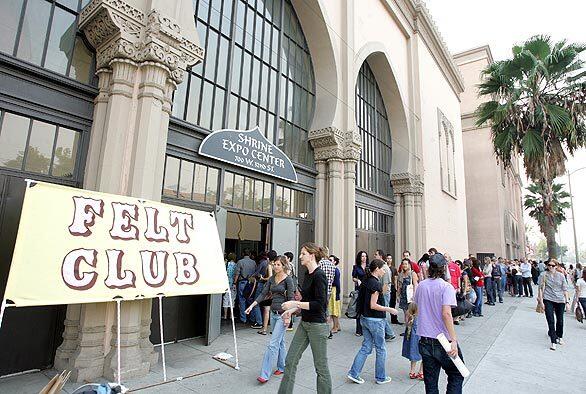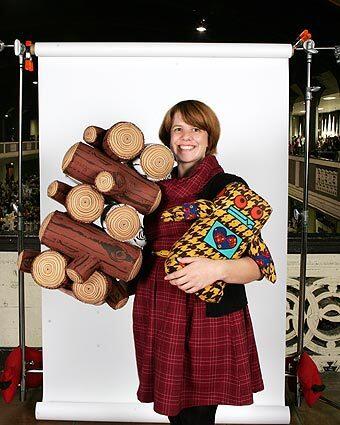Felt Club’s big show

People queued up for the Felt Club craft show and sale Nov. 16 at L.A.’s Shrine Auditorium Expo Center. The economy may be tanking, but for Southern California’s community of crafters, the future is looking surprisingly plush. The Felt Club show drew about 4,500 shoppers, who perused 144 booths jammed with homemade housewares, cute crocheted critters and stuffed felt cupcakes. The events success is just the latest proof that a long-simmering national movement continues to grow, and old-fashioned crafts are being revived in fresh ways among the under-40 set. (Stefano Paltera / For The Times)

The Felt Club show was packed. Turned off by overconsumption and mass-marketed goods, more cash-strapped young adults are either seeking one-of-a-kind pieces or making their own. They may not make an afghan like their grandmothers did, says Tina Barseghian, editor of the quarterly magazine Craft, but they will take the technique and apply it to their own home. (Stefano Paltera / For The Times)

Erika Kern came down from Bakersfield to sell her creations at the Felt Club show. She pieces together a modest living as a full-time maker, the term for a growing legion of young do-it-yourselfers. Kern paints, prints and sews patchwork robots and felt log pillows for $45 apiece at fairs and through her website, My Imaginary Boyfriend. (Stefano Paltera / For The Times)

Narumi Ogawa creates crocheted tableaux of succulents and marine life. Felt Club is the local community getting together for a shared experience and making money, says Ogawa, author of “Mr. Funkys Super Crochet Wonderful” and creator of the Mr. Funky website. (Stefano Paltera / For The Times)
Advertisement

Jenny Ryan, founder and promoter of the Felt Club show, holds a sign promoting the event. Ryan says the name is a tribute to the film Fight Club. Instead of using our fists, we use glue sticks and googly eyes, she says. (Stefano Paltera / For The Times)

Jane Morris, a Marina del Rey embroiderer, decorates bedroom décor and kitchen linens with pre-World War II patterns. She remembers the first Felt Club event in early 2006, describing it as “12 vendors in the blazing sun” selling out of a parking lot behind a comic book store on Hollywood Boulevard. (Stefano Paltera / For The Times)

Angie Myung started her craft business with funky wallets. Now her Los Angeles firm, Poketo, makes T-shirts, stationery and these melamine plates, which sell for $10 apiece at the Museum of Contemporary Art store, among other places. I like the sense of community we have built., Myung says of Felt Club. In this day and age of manufactured goods from who-knows-where, its good to have a face-to-face conversation with people who are buying and selling. (Stefano Paltera / For The Times)

San Diego ceramic artist Sandra Sharp is an advertising art director by day and a crafter by night (and on weekends). The Nov. 16 show was her first Felt Club event but her fifth craft show this year. She quickly sold out of her wheel-thrown, hand-decorated ceramic birdhouses sold for $45 each. (Stefano Paltera / For The Times)
Advertisement

Tanya Aguiniga poses with some of her felt birds and wool pillows. Aguiniga, who sells pieces at Reform Gallery in Los Angeles and has exhibited her felt furniture at the prestigious Art Basel in Miami, says she takes a booth at Felt Club for the personal interactions. Its a nice opportunity to sell smaller items and let people buy my work more affordably, says the Atwater Village artist who offers close-to-wholesale prices at the fair. I get more out of it, financially and creatively, when I sell one-on-one. (Stefano Paltera / For The Times)

Angie Diersman designs and sews her devil and zombie oven mitts, which sell for $18 a pop, and her Day of the Dead aprons, $30 apiece. She says she averages $1,000 in sales at Felt Club events. (Stefano Paltera / For The Times)

Whether its cool videos on YouTube or handmade gifts, people like being able to find new things for the first time, says Wilhelm Staehle, shown with wife T.D. Rio, his partner in their off-kilter Victorian emporium called the Bazaarium. Their products include soaps shaped like a pistol and an old cameo, and framed artwork depicting the silhouette of a little boy devoured by a bear. (Stefano Paltera / For The Times)



